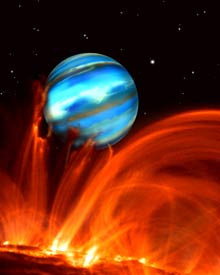
Not a pleasant place to be: a hot Jupiter hovers near its parent star. This composite image combines art of an exoplanet and a TRACE satellite image of magnetic loops of hot gas on the Sun.
Courtesy David Aguilar (CfA) / TRACE / NASA.
For the first time ever, astronomers have detected light from objects that everyone agrees are extrasolar planets. Using the Spitzer Space Telescope, two teams independently picked up infrared light emitted by the "hot Jupiters" TrES-1 and HD 209458b, which transit their host stars periodically. These observations have yielded precious information about both planets. But they also present a mystery: why is HD 209458b puffed up?
Using Spitzer's Infrared Array Camera at wavelengths of 4.5 and 8 microns, a team led by David Charbonneau (Harvard-Smithsonian Center for Astrophysics) observed TrES-1's host star for 5.6 hours on October 30–31, 2004. The team timed its observations to catch the star for the 3 hours when the planet was passing behind it. The Spitzer data easily revealed that the system dimmed slightly during this secondary eclipse.

If an exoplanet orbits its host star at an angle nearly perfectly edge on to Earth's line of sight, the planet will transit the star once per orbit. But it will also pass behind its star each orbit, an event called a 'secondary eclipse.'
S&T diagram by Gregg Dinderman.
By subtracting the infrared brightness when the planet was hiding from times when it was in view, the team could measure the planet's infrared emission directly. This allowed a rough calculation of the planet's temperature: 1,060° Kelvin (1,450°F). The team also calculates that the planet reflects about 30 percent of the star's incident energy. TrES-1's estimated temperature and reflectivity agree closely with theoretical expectations for gas-giant planets orbiting very near their host stars.
As predicted by Adam S. Burrows (University of Arizona) and other theorists, TrES-1 appears brighter at 8 microns than at 4.5 microns. "Maybe we're seeing evidence for atmospheric composition," says Charbonneau, noting that carbon monoxide absorbs light at 4.5 microns. Burrows adds that the planet's luminosity at both 4.5 and 8 microns hints that water vapor might also be present. He expects future Spitzer observations at other wavelengths to yield a crude spectrum, allowing astronomers to infer the presence of other molecules in TrES-1's atmosphere.

When the transiting exoplanets TrES-1 and HD 209458b pass behind their parents stars, the total infrared light of the system decreases. The Spitzer Space Telescope recorded these light curves showing the dimming of the system's infrared light.
Courtesy David Charbonneau / Drake Deming / NASA / JPL / Caltech.
Using the same method, a team led by Drake Deming (NASA/Goddard Space Flight Center) observed HD 209458b's host star on December 7, 2004. Deming's team used Spitzer's multiband imaging photometer to observe a secondary eclipse at 24 microns. Like Charbonneau's group, Deming and his colleagues had no trouble detecting the planet's infrared emission. But since they observed at a longer wavelength, where zodiacal dust adds noise, their temperature estimate of 1,130°K (1,580°F) is less precise.
Both teams found that the time from a transit to a secondary eclipse is exactly the same as the time from a secondary eclipse to a transit. This result, combined with radial-velocity data of the host stars, shows that both planets have almost perfectly circular orbits, in line with theoretical models showing that tidal interactions with the star will quickly circularize the orbit of a hot Jupiter.
But in the case of HD 209458b, the circular orbit poses a conundrum. Of the seven known exoplanets that transit their host stars, HD 209458b has the largest radius: 35 percent greater than Jupiter's. (TrES-1's radius is only 4 percent larger.) Yet both planets have about 70 percent the mass of Jupiter and receive about the same energy from their host star. Astronomers thought that another planet might be tugging on HD 209458b, inducing a modest orbital eccentricity that would allow the star to raise tides and heat the planet's interior enough to puff it up. But that explanation can now be tossed out the window.
"The anomalously low density for HD 209458b is now one of the biggest mysteries of known exoplanets," says Sara Seager (Carnegie Institution of Washington), a member of Deming's team. "I can guarantee you that theorists are working hard on an explanation. But as yet there are no good explanations."
Other teams have directly imaged a low-mass object orbiting the brown dwarf 2M 1207. But this object's estimated mass of 5 Jupiters only has been inferred from theoretical models, so it's not certain whether it is indeed a "planet." Moreover, the two objects are so similar and so far apart that the system seems more like a binary brown dwarf that a planet-star system.
Since TrES-1's and HD 209458's radii, masses, and densities are known, and since they orbit real stars, there's no doubt that these objects are "planets" by any definition. "The detection of photons from two exoplanets opens a breathtaking window on direct study of exoplanet atmospheres," says Seager. "For the first time, we will have the opportunity to study the composition, temperature, and even winds for a number of exoplanet atmospheres."
 0
0
Comments
You must be logged in to post a comment.